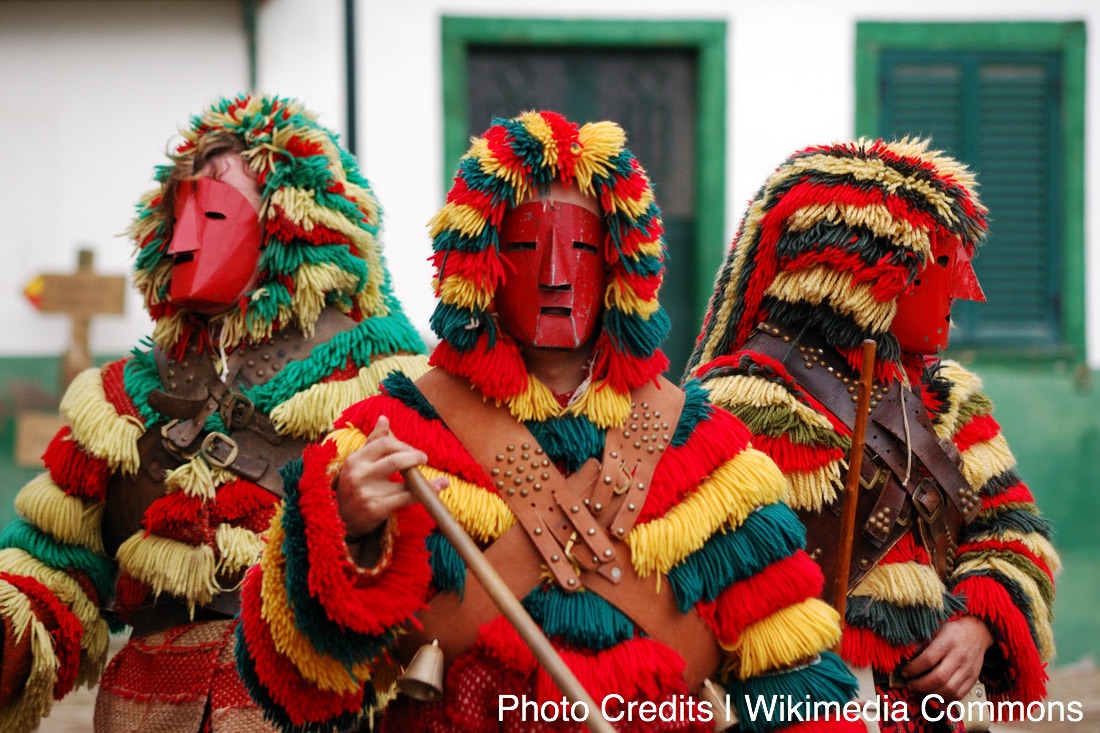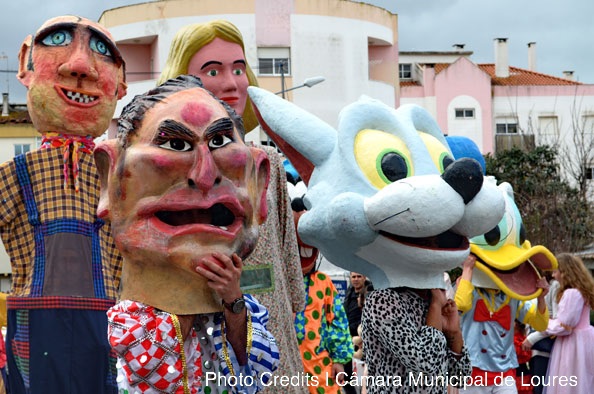|
The origin of this festivity dates back to ancient times, when people celebrated pagan gods and the mother nature. Many centuries later, the church recognised the Carnaval as a religious celebration, and it is now seen all around the world. Carnaval, or entrudo, are the three days before Ash Wednesday. The main celebration is the “Fat Tuesday”, the last day for people to party and eat and drink too much. The word Carnaval has latin roots and means “farewell to meat”, as during Lent (the 40 days until Easter Sunday) devoted catholics give up their main pleasures, including meat. In Portugal there is a big tradition when it comes to Carnaval festivities, since the Middle Age. Not only from north to south, but also in the islands of Azores and Madeira, Carnaval is celebrated with a bang! Portuguese people tend to believe “No Carnaval ninguém leva a mal”, a saying that means no one takes personally what is said and happens during this time of the year, being a time of excess and revelry. If you are around in the pre-Len, do not miss the Carnaval celebrations we have picked, as they’ll probably be the highlight of your trip! Carnaval in PodenceIn the northern hills of Portugal, more accurately in Podence, Carnaval is still celebrated as a pagan festivity, honouring the oldest of the traditions. The parade involves the young boys (Caretos de Podence), who wear masks and dress up with colourful vests and the young girls that haven’t married yet. The caretos run across the village rattling the bells they wear around their waist, chasing and challenging the young girls. This celebration is inspired on the roman festivities that worshiped Pã, the god of the herds, the fertility and the shepherds. At the time, men ran semi-naked through the streets and hit the women with goats skins with the intention of making them more fertile. Many of the vests are kept for generations, so they are true family relics. They are woven by hand on looms by the women in the village and the traditional colours are red, yellow and green. Some say that just for the outer hanging strings are necessary 60 yarns of wool. On the morning of Ash Wednesday, the boys leave the costumes at home and go to mass. From that day it is a sin to hear a rattle. Even the animals in Podence do not usually have bells around their necks. Carnaval in LazarimIt is considered the most authentic Carnaval in the whole country, keeping old traditions alive. You can hear the oldest people in the village telling stories they claim to know about, dating back to the medieval times. According to them Carnaval was when scary and creepy creatures wandered around the villages. The Carnaval in Lazarim, known as entrudo, is famous for the amazing wooden masks that are sculpted by local artisans. You can spot devils, bearded men, mad faces, pointy ears and horns. Apart from the spooky parade, every year the godfather and the godmother - kind of the the ambassadors of that year’s Carnaval - dress in black and read out loud some rimes and charades that criticise and make fun of the boys and girls of the village, revealing the secrets they have been keeping for a whole year. The parade finishes with a bonfire where a couple (don’t panic, they’re only dolls) are burnt to ashes. Nowadays, these dolls are fireworks that burst, dance and light up the sky. No party is over without music, food and drinks, so the whole village gathers and celebrates together. Carnaval in Canas de SenhorimThe Carnaval in this village has a history of around 400 years, being one of the oldest and most traditional in the country. This festivity follows the history of the village. It all started with a dispute between the wealthy and the most humble inhabitants of the village, who used to challenge each other during Carnaval. Even nowadays there is a “battle” between two main parades, that after marching through the streets of Canas de Senhorim, confront each other in a battle of singing and dancing. In this village the celebrations are long and loud. It all used to start on the 6th of January, with a tradition called Paneladas, when people used to throw clay pots full of ashes and dust inside other people’s houses, causing a lot of noise and confusion. As you can imagine there’s not much people eager to participate in this game, so it is not very common anymore. However, other traditions have remained, such as the Farinhada (throwing flour to the young girls) on Monday morning, the Segunda-feira das Velhas (an afternoon when the locals sing old songs and wear costumes inspired in the past), the Tuesday parade, the Batatada (a massive feast of codfish with potatoes, eggs, cabbage, bread and wine) and the bonfire on Wednesday night (when the locals burn the entrudo clown), a sign that the party is over and Lent is about to start. Carnaval in OvarThe history of the Carnaval in Ovar had its highs and lows, but now it is definitely one of the most talked about Carnaval celebrations in Portugal, and only for good reasons! There are over 20 organised groups that have the honour of parading during the biggest event in town! Carnaval in Ovar takes almost a whole week, from parties, to kind of mascaraed balls, and of course the massive parades that take over town on Sunday and Tuesday, just before Ash Wednesday. They take months of preparation and they are by far the biggest touristic attraction in the area. The themes are carefully chosen, the costumes are more and more intricate, the dance choreographies harder to memorize and the time spent organising everything is mind-blowing. After all, every single group wants to conquer the title of the best of the year! There are even samba academies. Yep, the Brazilian rhythm hit us too thanks to “Costa de Prata”, a samba school that lit the fuse and paved the way for a few other. Some say the emigrants from Ovar that returned from Brazil after the revolution found a more open minded country and planted the seed to a big transformation. From the youngest to the oldest, no one can avoid the madness of the Carnaval in Ovar. The streets are full of laughter, music and colourful costumes, and even if the weather is a bit grim the good vibes will bring a smile to your face! Carnaval in Torres VedrasCabeçudos, matrafonas, carros alegóricos are big words that are hard to pronounce, but every single person who knows the history of the Carnaval in Torres Vedras knows them well. The tradition is old and the celebration is big, with the excessive and inappropriate behaviour that caracterizes this festivity. Matrafonas, men dressed as women, are definite one of Torres Vedras biggest icons. Nowadays they represent a satire to the society, but their origin was way more simple. It all started when men started dressing up with their wives’ old clothes because they could’t afford new costumes. Carros alegóricos, are vehicles that carry a message. Literally. The themes range from politics to celebrities, society to sports, and it is always a mockery to what is going wrong. Back then they used to be two wheeled carts pulled by animals, but they served the same purpose. Cabeçudos are huge face masks, originally made with paper mache paste that are also very iconic in this Carnaval. Each year there’s a main theme, and everyone dresses up accordingly! If you spot octopuses, sharks, mermaids and schools of fish swimming around Torres Vedras this February don’t be alarmed, they are part of the plan! Carnaval in LouresThis celebration dates back to 1934, however some years later it was forbidden because it grew too much. In the 70s it started again, only to be stopped a few more times. Despite the troubled history, it is a Carnaval that deserves being mentioned. First of all it has the biggest organised Carnaval group in the whole country: the "Mastronças do Moulin Rouge”, a group of men from 3 to 70 years that dress up like women and participate every year with intricate and original costumes. This Carnaval is also famous thanks to the parade, the Baile Trapalhão - translates as the clumsy ball, a party where each person is meant to wear the weirdest mask possible, and the Enterro do Rei do Carnaval - the burial of the Carnaval king, probably the funniest and most peculiar event. Carnaval in FunchalIn the island of Madeira the celebrations continue! According to some authors and researchers the origin of this Carnaval dates back to the golden period of the sugar production, in the 16th century. Maybe that was what triggered the amazing Brazilian carnaval, with the trading of goods and people between Madeira and Brazil. Funchal is the city to head to! The sound of traditional music bands and carnaval parades bring people to the streets and everyone parties till late in the evening, for a few days in a row. The main parade hits the street on Saturday and after that there is, of course, a dance show. But it is on Tuesday that the party goes over the roof. During the afternoon there is the cortejo trapalhão (clumsy parade). During all these days Funchal is decorated with lights, colourful flags and there is music all over town. Carnaval in TerceiraIn this island, part of the azorian archipelago, you can witness one of the most bizarre Carnaval celebrations: Danças e Bailinhos de Carnaval. Even though it translates to dances, it is more than that. It is kind of a hybrid type of dance as it shifts from dramatic performances and plays to a choreographed dance. Originally there were three distinct groups of people: the dancers, the actors and the singers. They were all organised and followed the instructions of the mestre, sort of the conductor of this intriguing mess. Nowadays the roles faded a bit, but the tradition remains. Every year there are around 50 different “dances”, which requires a big and hard-working team to take care of all the aspects. The cast then tours throughout the islands’ many stages.
0 Comments
Leave a Reply. |
Categories
All
|
Telephone+351 938 503 009
|
|
Turismo de Portugal RNAVT nº 6915
|














